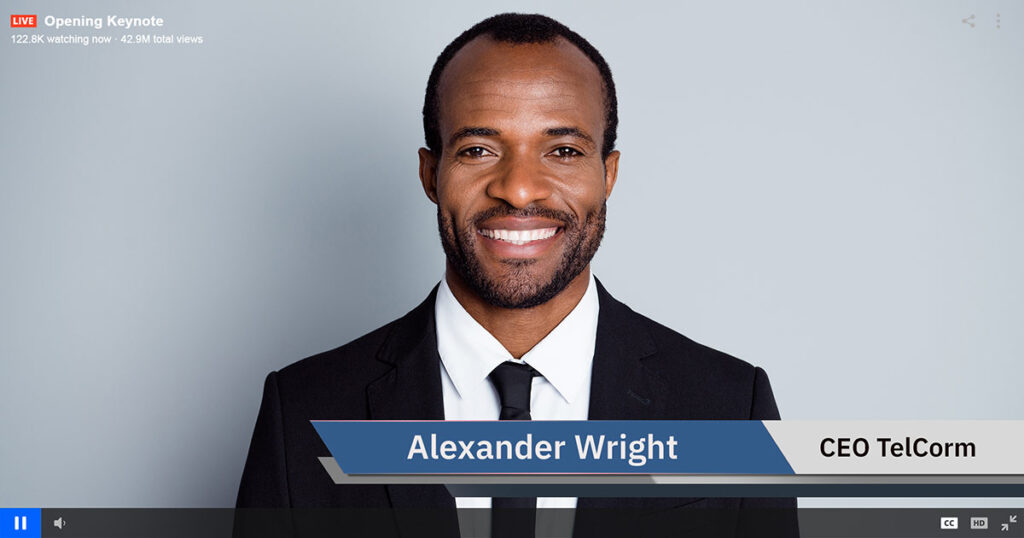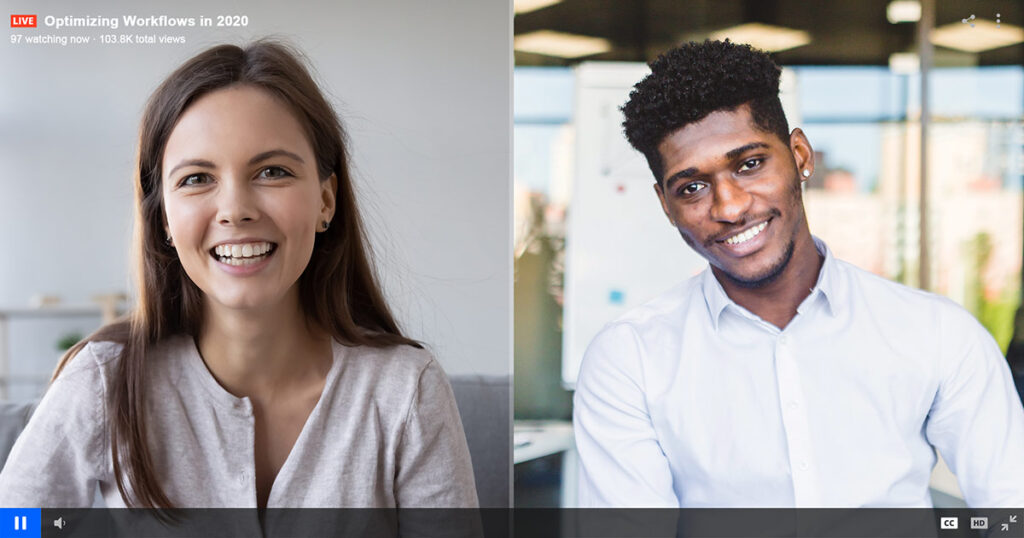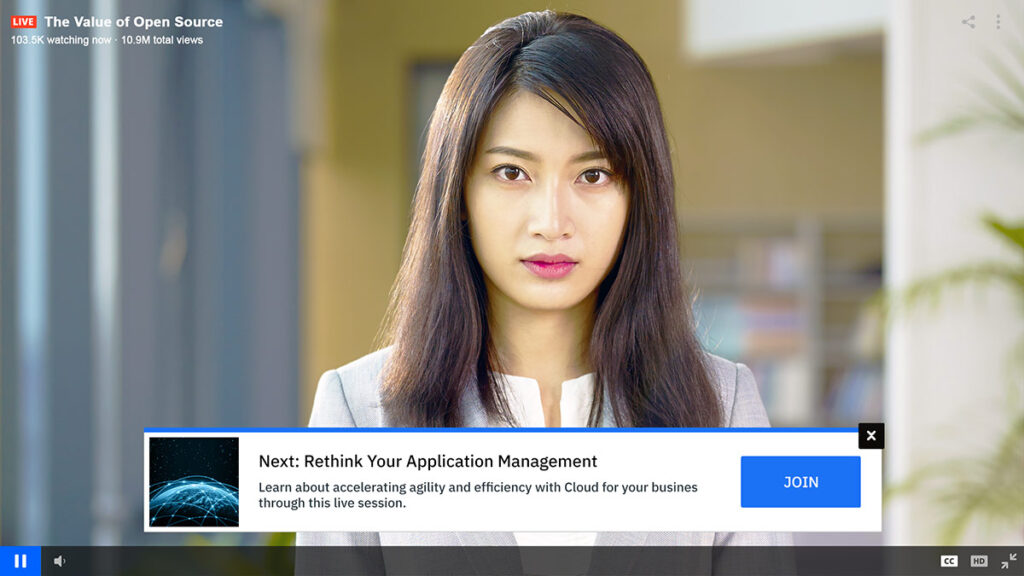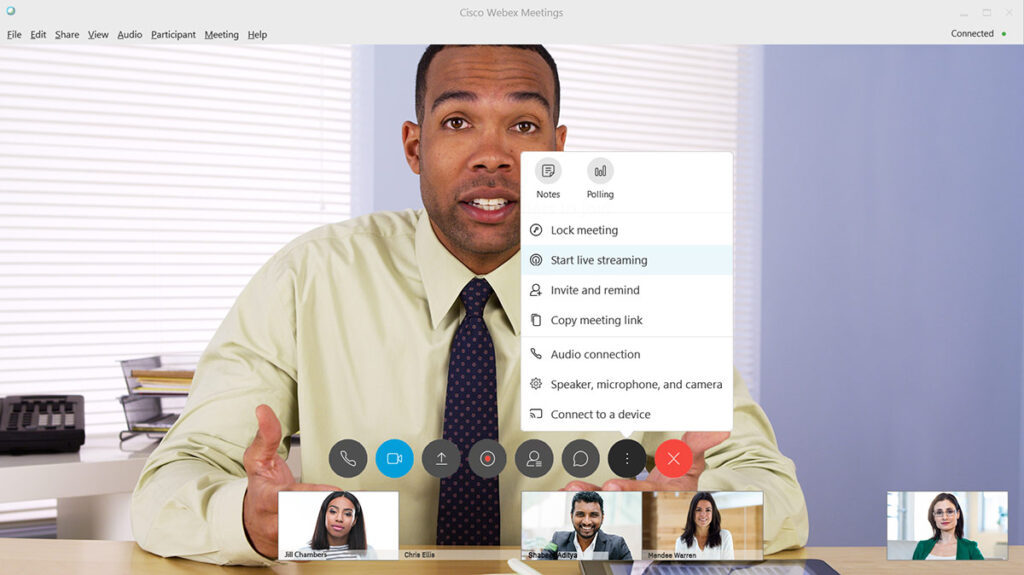
Have you transitioned an in-person conference or event recently to an all-digital experience? Before COVID-19, many businesses focused on in-person opportunities to drive engagement. But once event cancellations started happening rapidly due to the need to social distance and related restrictions, businesses across virtually all industries were forced to take a very close look at how they could quickly pivot their efforts to digital.
This blog outlines some key insights from the last few months of activity in creating digital events. It details how IBM Watson Media has been able to help many clients with these efforts to live stream conferences, including our own IBM Think Digital event, providing considerations for your own virtual conference.
- New normal for conferences and events
- It’s hard to predict audience size for digital events
- Registration, authentication and tracking options can be confusing
- How to get sponsors excited about your digital event
- Interactivity and networking in a virtual event space
- Choosing between pre-recorded, live, and semi-live sessions
- Presenter training and ease of use
- Highly customized digital experiences
- What to look for during the event to prevent things from going wrong
- Delivering a post-event digital experience on-demand
- Video streaming for digital events: IBM offerings
New normal for conferences and events
Most of the world is still many months away from going back to mass gatherings, and the transition will likely be gradual. But, will in-person conferences ever return to what they were pre-COVID-19? That is debatable. Regardless, companies and event organizers are focusing now on how to deliver exceptional digital experiences even after lockdowns are lifted. Many are realizing that when people don’t have to travel, audiences can become significantly larger.
In evaluating recent events that have pivoted to digital, Jim McGregor, Principal Analyst and Partner at TIRIAS Research states, “Registration for many of the industry events has risen by 2-10 times the number of the in-person events.” Many organizations may look back at 2020 digital event results and re-evaluate whether or not to go back to in-person events at all, or may opt for a hybrid model where a smaller number attend in person with a larger digital audience.
Due to COVID-19, event organizers are re-evaluating event technology solutions, including video streaming, lead registration, attendee engagement, event ticketing, access control, live interaction tools, virtual exhibit halls, online networking applications, etc. Below are some of the most common challenges and some ways to address them.
It’s hard to predict audience size for digital events
If an event has been running for years as an in-person event, and you want to pivot to digital, it can be very tricky to determine what your online audience size will be and plan accordingly. And, since the cost of many digital event solutions are based on volume, this becomes a critical factor to analyze. Consistent with the TIRIAS Research statement mentioned above, most companies IBM has worked with recently have reported larger than expected digital event audience sizes after pivoting an in-person event to digital. Our own IBM Think event pivoted to Think Digital in May, and we far exceeded original audience size estimates of somewhere between 60-100k viewers. The actual count was 179k unique viewers during the live event.
In order to estimate potential audience size, you can factor in previous years’ in-person attendance, online views of prior years’ sessions if they were streamed live, as well as on-demand views. Consider also how you will be driving registrations, especially if you are going to be doing paid media campaigns to drive attendance. Regardless, it’s important to recognize that if you’ve never gone digital before, there is a good likelihood that you will exceed your expectations and you should plan for additional capacity.
Registration, authentication and tracking options can be confusing
Because most event organizers plan detailed engagement follow-up campaigns post-event, there has been a lot of emphasis around how to manage registration, regardless of whether the event is being offered free or whether purchasing a ticket is required. In 2020, a lot of events were already taking registrations through many different systems. These registration solutions managed invite attendee statuses, payments, follow-up emails, etc. When this type of system is already in place, its best to have your digital event platform integrate with the existing registration system so you don’t have registered users in more than one system.
Another consideration, regardless of the registration system being used, is whether or not to have a cutoff date where you will stop taking registrations. Having a cutoff date can make it easier to manage, but will undoubtably limit your overall reach. Let’s face it, when people don’t have to make travel plans or other arrangements to physically be at your event in-person, they wait. Digital events are notorious for last minute sign-ups, including registrations after the event has already started! Many events, including IBM Think Digital, opted to have some main thought leadership sessions be completely open to the public and not require registration in order to maximize reach, while all other sessions required registration and authentication in order to track engagement. Having some sessions available to watch without authentication also gives those last-minute registrants something to watch while they are clicking through the registration screens to help ensure they don’t get frustrated and bounce out of the event experience.

Requiring registration also is directly tied to engagement reporting. Afterall, if no one authenticates, you will only be able to track anonymous engagement. Authentication means you will be able to leverage reports showing what specific sessions an attendee viewed, which sessions were watched the longest, in which sessions were they actively engaged in chat, Q&A, what actions did they click on, etc. All of this can be highly valuable information you can leverage in your post-event follow-up campaigns.
How to get sponsors excited about your digital event
When you have sponsors and/or exhibitors who have paid fees to come to your in-person event and that event is now pivoting to digital, it can be very challenging to keep them on-board for the digital version of the event. Of course, you’ll want to have your sponsor logos on your digital event pages, however, there are many other ways to provide benefit to your sponsors and exhibitors during the actual event and help ensure they get what they paid for. Here are some ideas:
- Give sponsors the opportunity to be featured in pre-roll ads that run before each session starts (the higher the sponsorship level, the more pre-roll ads they get).
- Use Call to Action video overlays to feature sponsor solutions that are related to what is being discussed during a session.
- Give each sponsor a virtual booth (i.e., dedicated streaming channel) and schedule dedicated exhibit hall hours for attendees to visit the booths.
- Encourage sponsors to upload videos and other content ahead of time and turn on simple registration gate features on their channel to capture leads. Allow them to do their own live streams during exhibit hall hours or at scheduled times to engage with visitors in real time.
- Encourage sponsors to offer contests and prizes to encourage people to visit their streaming channel.
- Offer the option to sponsor a virtual cocktail hour where you have a mixologist or a sommelier streaming live and engaging the audience in an entertaining way.
- Have sponsor channels be a part of the post-event experience by keeping their content available for on-demand streaming as well.
Interactivity and networking in a virtual event space
The most common interactivity components for digital events are open chat rooms, Q&A modules, and online polling. In addition to that, some platforms also offer call to action video overlays or clickable pathways that can help viewers transition from one session to another. IBM offers all of these features and recently, customers have been using them in some very unique ways to increase engagement during events. Here are just some of the innovative ways these features can be used:
Chat is most commonly used during a session to allow participants to engage in discussion about the topic being presented while they are watching. However, we’ve seen chat being effectively used in-between sessions as well for networking. For example, the event can have “Coffee Break” streaming channels setup for particular “bird of a feature” groups or following specific event tracks. Relaxing or energizing music might be played and people can come in and chat with each other and connect virtually. Although not available out-of-the-box, the Think Digital team customized the open chat feature in order to allow people to connect to a specific person in the larger chat room and then breakout to have a private chat. This was also used by IBM digital sellers to actively engage participants from their accounts during the event via 1:1 chat.
Q&A is typically used in a similar way and normally there is a session moderator that is monitoring, and responding to, the incoming questions during a live session. Many event organizers have also been leveraging Q&A to enhance engagement with sponsors or exhibitors who may have dedicated streaming channels going on during the digital event or at times when there is a dedicated time to visit the virtual exhibit hall and explore solutions being shown in Sponsors’ channels along with live Q&A.
Polling is something that most event organizers use to keep the attention of people watching by giving them something to actively respond to. Polling topics can range from fun topics that are purely for entertainment to live polls that actually impact what the presenter will discuss live. Either way, asking people some multiple-choice questions and getting live real time results is a great way to help keep people actively watching vs. clicking away to check their email.

Calls to Action (video overlays) can also be used to increase interactivity. The most common use for these is to provide a way for the viewer to take immediate action about whatever is being discussed (go donate now, or buy this product now, or sign up for this course now, etc.). Additionally, we’ve seen these used toward the end of an event session to provide an easy click pathway to the next recommended session, so people don’t need to navigate to the agenda.
Recently, event organizers have also been experimenting with and looking for more 1:1 networking capabilities within digital event experiences, including ways to do 1:1 video communications within a larger video streaming event. As of now, some event platforms do provide some of this, but most (maybe all) can’t scale up to accommodate thousands of participants and can be very expensive. As the demand for digital events continues to grow as a result of COVID-19, this is an area ripe for innovation.
Choosing between pre-recorded, live, and semi-live sessions
Mitigating risk while still allowing interactivity is the name of the game here. Budget and platform choice are key factors as well. It’s fairly understood that people prefer watching events that are truly live, but that doing anything live presents greater risk. Especially if you have speakers who will be connecting from their home and relying on their home internet connection, that might be too much risk for most events. But, if you pre-record everything, there could be negative engagement impacts if you don’t find a way to incorporate some element of live interaction. Another consideration is how many video channels you’d want to be broadcasting live at the same time and the capacity of your team to manage all real-time switches on multiple channels at once. During COVID-19, hybrid approaches with a combination of pre-recorded and live components have become popular.
IBM streaming solutions provide options for you to choose between pre-recorded, or live, semi-live or hybrid. In a semi-live or hybrid scenario, you may choose to have your speakers pre-record the session and then the resulting video will just play along with live chat or Q&A. Then, you may choose to have the same speakers join an actual live session immediately following it to further engage with the audience. In this scenario, even if one of your speakers has terrible connection problems during the Q&A, at least their main presentation wasn’t impacted. There are many benefits to doing it this way, but it does require a lot more coordination. You’ll need to have someone actively playing the role of event producer and managing all of the live switching that is required. Alternatively, you could choose to pre-record absolutely everything and load the videos into a live playlist that would run during your event. When you use a live playlist, you can still have live chat, Q&A, polling, and Call to Action interactivity options turn on for truly live engagement during your event. This option eliminates the risk of individual speakers having poor connections during the event. Finally, if you are able to have speakers present from a studio environment where video production professionals have setup everything to ensure connections will not be a problem and there are failover systems in place to help ensure that, then doing your event entirely live may be a great option.
Presenter training and ease of use
Many organizers underestimate the importance of dry runs. Especially when pivoting to an all-digital event, coaching presenters on the details of the tools they will be using is supremely important. This becomes even more critical when speakers are delivering their sessions from home without professional video production staff on-site to assist. They’ll need help with microphones, camera setup, lighting, and physical room choice. These small details can usually be managed remotely and can make or break the quality of your event experience.
During COVID-19, most event organizers have been opting to have speakers record their sessions using tools they are already familiar with. The most popular tools seem to be Webex and Zoom, especially when slides are required. You might be thinking, why not just use these tools to run a large digital event? While Webex, Zoom, and similar web conferencing solutions are great for creating content as well as for hosting video meetings with appropriately sized team, using them to run a large digital event is not usually suitable. This is due in part to seat limits and overall lack of the ability to scale to very large audiences, but also has to do with the complexities and distractions that occur when too many people are interacting with audio and video on a live session.

Most event organizers want their event to feel a lot different than just a regular Webex meeting. Fortunately, IBM streaming solutions can extend the reach of both Webex and Zoom sessions easily. For pre-recorded sessions, the resulting videos can simply be uploaded into the IBM platform (and added to a live playlist for an event). For live sessions, speakers can connect to Webex or Zoom and can see and talk with each other (i.e., on a panel), while audience viewers can just go to the streaming URL to watch and interact with chat, etc. In this way, the streaming URL can accommodate a much larger audience and has been tested to support up to 1.2 million concurrent viewers. Once you are using the streaming platform, you have a lot more flexibility to enhance the overall experience by incorporating other elements.
Highly customized digital experiences
There are many out-of-the-box virtual event user experiences to choose from. Most offer some flexibility in terms of where your video will be in relation to slides and other interactivity elements. And most offer some customization options so you can place your logo on the page and adjust some of the color pallet, etc. For most digital events, this may be enough. However, especially for very large conferences with bigger budgets, a custom user experience may be required. As more and more digital events are happening every day, there is more pressure for event organizers to find ways to stand out and not just have their event look the same as the last several events a person might have attended.
IBM streaming solutions can accommodate many options. We offer out of the box solutions for streaming channels and video portals that can be custom branded with options to turn various settings on and off and adjust placements. We also have flexible options to embed on-demand videos and carousels as well as live streams with or without different interactivity options onto any website. Customized services are also offered either via IBM Global Services or one of our IBM Watson Media business partners who can leverage our APIs and SDKs and build highly customized dynamic event experiences to help your event stand out.
What to look for during the event to prevent things from going wrong
While you will never be able to absolutely prevent users’ individual connections from going haywire, there are a few things you can do to mitigate risk. For one thing, provide self-help and troubleshooting for the individual user and make sure that it is highly visible throughout the event. This can dramatically help with the inevitably high volume of issues like the computer sound not being on or a video buffering due to poor cell connection, someone’s screen resolution making things fall off the page, etc. For example, IBM customers often create a Help Desk or 411 channel that is monitored for live chat or Q&A throughout the event.
Your stream ingestion point (where you are physically broadcasting from) is extremely important and you’ll want to make sure you have a strong internet connection and nothing else competing for bandwidth. This can all be prepared and tested before your event starts. But, once you are streaming live, you’ll want to be monitoring the event and watching your stream health to make sure things are going well. And, to further mitigate risk, you should know what type of content delivery network(s) are being leveraged to deliver your digital event streams to participants in various geographies. Ideally, choose a solution that provides automated failover to multiple CDNs so that if one fails there is always another one picking up the stream. IBM’s streaming solutions leverage many different CDNs with automatic failover to help ensure a smooth experience for your audience regardless of where they are and what device they are using to connect.
Delivering a post-event digital experience on-demand
Not everyone has hours to sit in front of a computer to capture the insight your company wants to share during your live event. Especially in these times of so many people working from home, it’s important to respect the schedules and individual challenges of your viewers and provide many pathways to consume the event content. Post-event, organize content in such a way that people can “jump” to certain segments. One way of doing this is to make sure that all sessions are streamed with closed captions so that after the event these transcripts from the captions can be used to power deep search. The IBM streaming solutions offer this capability to make it easy to search for specific videos or jump directly to the moment within a video when a specified phrase or keyword was spoken.
From a registration perspective, keeping your digital event open for registrations can also continue to increase the overall lead count associated with the event. It’s likely to be most critical during the first month or two following your event as many people who attended some sessions live will want to come back and watch the ones they missed. But, it’s also likely that people will refer others to register and watch so your overall registration count can continue to grow. You can also leverage the content in other drive to campaigns to pro-actively drive new registrations. And, of course, it’s nice to feature the prior digital experience to encourage people to register for your next event.
Video streaming for digital events: IBM offerings
IBM has two streaming options that are both often used to live stream conferences and power digital events. Here is a quick explanation of how they are used and why you might choose one versus the other (and sometimes use a combination of both).
1) IBM Enterprise Video Streaming – This platform is used to stream to authenticated individuals. This could be people who are all part of the same organization authenticating via single sign-on or people who are approved via email authentication or a 3rd party registration system is used for real-time registration sync. This product is focused on providing secure rich access to live and on-demand video streams.
2) IBM Video Streaming – This platform is used to stream to individuals either via Open URLs or URLs that require a password before entry. An optional registration gate can be leveraged, but it captures lead detail for tracking, and does not restrict the person from watching. This product is less secure but provides maximum ease of use and less clicks to watch.
Outside of the security and registration differences, both IBM offerings provide similar capabilities. A detailed list of the features that differ between the platforms is available online.
For IBM streaming customers, decisions around registration often guide which product(s) will be leveraged, but there are variations. Here are a few scenarios:
- Use IBM Enterprise Video Streaming and integrate it with a 3rd party registration/payment system that was already in place. This is often the case with larger events that are pivoting to digital and require authentication for all sessions. This option is highly secure to ensure only authorized/paying viewers are allowed in.
- Use IBM Video Streaming and embed the video player inside of a website that already has its own authentication system in place. This option is less secure, but in practice, it’s unlikely that anyone would ever be able to determine the external URLs to watch the videos outside of the website experience.
- Use IBM Video Streaming without any authorization at all and just allow public viewing of all video streams.
- Use a combination of both platforms (available via a single login) and have some sessions require authentication and others be open to the public.
The future of in-person events is at risk
There are many who believe in-person conferences may become a thing of the past even after COVID-19 restrictions are lifted, fueling the debate that has been going on for years about whether the costs associated with in-person events are really worth it. But, some believe large events will come back in full force and you can never truly replace the value of the in-person interaction. Regardless of whether we fully return to conferences of the past, I expect digital event demand will increase. The most likely scenario seems to be that most will opt for a hybrid approach with smaller sized in-person audiences, combined with larger groups of people participating digitally. The next year is ripe for digital event innovation and those of us in the business are looking forward to things to come!